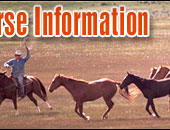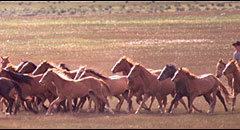 |
   |
|
|
|
You are here: Horses > Horse training > Vet etiquette |
|
Horse Vet Etiquette:
Keeping Your Equine Calm During an Veterinary Medical Exam
Horses, like people, have different temperaments, so while
some horses are the perfect patients, when the vet comes to
visit, other horses act up. Having a calm horse who's ready
to get to work when the veterinarian arrives is one way to keep your
horse happier and your equine doctor and those around the stable
safer. |
|
|
Acclimate Your Foal to a Vet Visit
If you're raising your horse from a foal, you have the ideal
opportunity to train him to work with the vet easily right
from the start. Most equines who have problems with
veterinary visits aren't used to being handled much,
especially by strangers. As soon as the mare will let you,
get your hands on the foal. Touch his neck, chest and face.
Put your fingers in his mouth. Touch his chest and his
flanks. Pick up his feet and get him used to a hoof pick by
tapping it lightly on his hooves. In short, teach your horse
that it's okay to be touched anywhere. |
Get Your Horse Comfortable with Strangers
Your horse should get used to being handled by more than one
person. Let your friends pet him, curry him and give him
treats. If your horse thinks it's normal to be touched by
all sorts of people, he'll be less likely to feel offended
when a total stranger comes in to take his temperature.
Another important part of teaching your horse to relax with
other people is to make sure that he or she has contact with
friendly people of both sexes: if a horse is only used to
one sex, an opposite-sex vet may have a difficult time.
Expose Your Equine to Poking and Proding
Some horses don't mind getting a shot—as long as it's on the
left side! Many people forget to work with their horses from
both sides. Make it part of your horse's daily activity to
be led, curried and mounted from the right. Also get your
horse used to things he would otherwise consider
indignities: look briefly into his eyes with a flashlight;
open his mouth and move his tongue to one side, then the
other; take his temperature. In short, teach him to become
comfortable with the various things that vets do for no
discernable (to a horse) reason.
Desensitive your horse to various veterinarian tools and sounds
Vets may use things like electric clippers, which can freak
some horses right out if they've never encountered them
before. Starting as young as possible, get your horse used
to the sound of clippers by running a pair near him, even if
you don't actually use them. Teach your horse that leg wraps
are a fashion must by putting them on for time to time when
your horse is in the stall. Use wraps made for polo or for
shipping, and let your horse become accustomed to the way
they look and feel. At some point, most horses sustain some
minor injury that requires wrapping, so when that happens,
your horse will understand what wraps are instead of trying
to get away from them.
Stand by Your Vet
Most of the time, when a vet is working with your horse, he
or she will ask you to stand on the same side. That way you
can communicate easily, and if the horse should decide to
act out, there's less chance of anyone getting hurt.
Exercise Your Horse Before the Vet Arrives
Unless your horse is stabled because of an injury, it's a
benefit to everyone to give him time to play outside before
the vet comes. A horse who's been locked up inside all day
will be a lot more restless than one who's had the chance to
run around a little and kick up his heels.
Your Horse Can Sense Your Stress Level Too
If you're not worried, chances are that your horse won't be
either. But if you're acting stressed, or are upset by an
injury or the upcoming sutures, you may cause your horse
distress. If you can't stand blood, find someone else to
help the vet and get yourself someplace where you won't be
adding to the stress your horse will be feeling. Preferably,
you'll be able to act calm and be helpful to the vet and
soothing to your horse. Some experts say that singing or
talking to your horse works.
Keep the Area Safe
Give your vet plenty of room to work by keeping equipment
and tools out of the stall. Catch the horse well before the
vet arrives to save time and also to give the horse a chance
to calm down after being caught. Good light is important, so
your vet can see what's going on, and providing him or her
with warm water and a clean towel to dry off with is a
kindness.
 |
Read the next horse training article on Buying a Horse Basic Tips. |
|
|
|
|
 |
|
|
|
|
|
Horse Education
|
|
|
|
|
Horse Information Topics
|
|
|
|
|
|
|
|
Horse Business Owners
|
| |
Advertise with Us
Have your horse products or services exposed to over 27,000 of our monthly visitors.
|
|
|
|
|
|